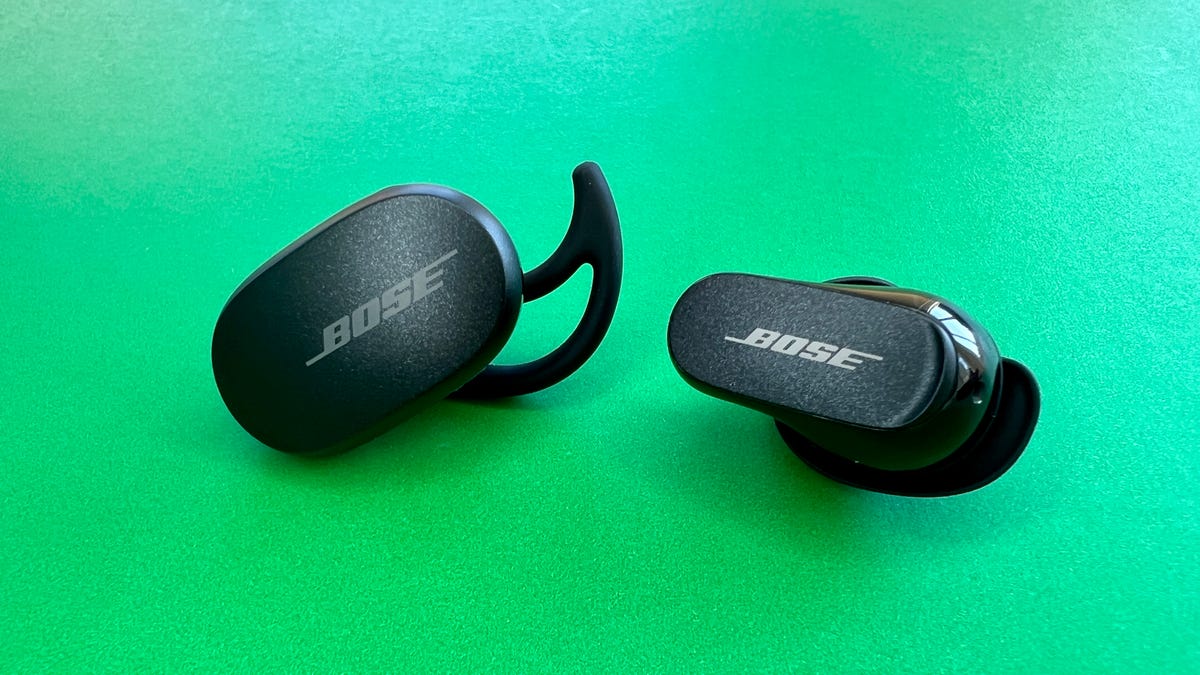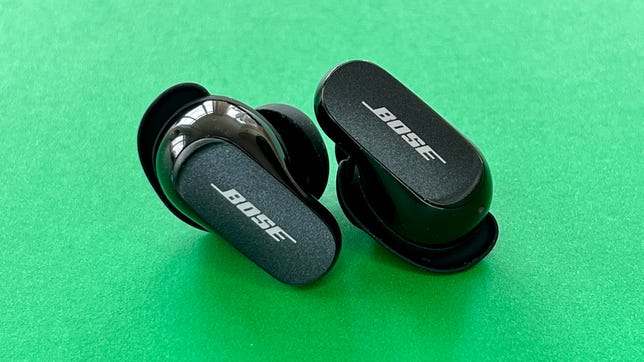Technologies
Bose QuietComfort Earbuds 2 Review: Best Noise Canceling, Bar None
Sony and Bose have been battling it out for noise-canceling supremacy the last few years. Bose has taken the lead once again with its $300 flagship earbuds.

Bose headphones and earbuds have always skewed toward the more premium end of the price spectrum and the company’s QuietComfort Earbuds 2 are no exception, carrying a hefty list price of $299 ( 279, $AU429), or $20 more than the original QuietComfort Earbuds. While that will put them outside a lot of people’s budget for wireless earbuds, their design and voice-calling performance are significantly improved from the originals, and they deliver excellent sound and outstanding noise canceling — arguably the best out there right now. They’re easily among our top current earbuds, and a CNET Editors’ Choice Award winner.
That award came a few months after the release of the QuietComfort Earbuds 2 after some internal debate — most notably the earbuds’ missing support for the AptX Adaptive audio codec that’s compatible with many Android phones and some other devices. But Bose has since announced that AptX support will be added in the spring of 2023. «The QuietComfort Earbuds 2 will support the AptX Adaptive codec for audio streaming, including Lossless and low-latency capabilities,» Bose told CNET, «and enable more seamless and robust connectivity with premium Android devices.»
I’ll save that value debate for the end of the review after I go through all QuietComfort Earbuds 2’s strengths (or QuietComfort Earbuds II, as Bose calls them), along with a few weaknesses. But if you can afford them, these are certainly strong competitors against Apple’s AirPods Pro 2 and Sony’s WF-1000XM4, the latter of which have been out for a while and are being aggressively discounted at times.
Read more: Best Wireless Earbuds for 2022
Like
- Excellent sound and best-in-class noise canceling
- Significantly smaller than their predecessors
- New Fit Kit ear tips and stabilizer system gets you a secure, comfortable fit
- Improved voice calling with better noise reduction
Don’t Like
- Pricey
- No wireless charging
- No multipoint Bluetooth pairing
- AptX support not coming until spring 2023
Product details
- Battery Life Rated Up to 6 Hours
- Noise Canceling Yes (ANC)
- Multipoint No
- Headphone Type Wireless Earbuds
- Water-Resistant Yes (IPX4 — Splash-Proof
Initially the buds were only available in black — or «Triple Black,» as Bose calls it, but you can now also get the in the lighter soapstone color (basically off-white) and it’s possible Bose releases other special-edition colors in the future.
More importantly, the earbuds are about 30% smaller than their predecessors. Their case is about 40% smaller and truly pocketable (though it’s still about 25% to 30% bigger than the AirPods Pro 2’s case). The smaller size corrects a big downside of the original QuietComfort Earbuds, which featured excellent noise canceling and very good sound quality, but were pretty hefty and protruded from your ears. The new buds each weigh a little less than 0.25 ounces, or 7 grams, according to Bose — still not svelte but significantly smaller.
The other big change is to the ear tips. Bose has ditched its one-piece StayEar wing tips for a two-piece Fit Kit system that features separate ear tips and «stability bands» in three size options. That’s supposed to give users more flexibility to get a secure fit and tight seal. I liked the StayEar wing tips, but after trying the new two-piece system, I’m sold on it. I ended up going with the large tips and medium stability band, and that really locked the buds in my ears. I can’t tell you that this will fit everyone’s ears equally well, but if you’re someone who can’t get a secure fit with the AirPods Pro 2, which are lighter and quite comfortable to wear, this new two-piece Fit Kit may be a reason to give the Bose a go over the new AirPods Pro.
A handful of new premium earbuds feature a kind of auto custom tune feature that takes into account the shape of your ears — and ear canal. Following that trend, Bose has developed a new CustomTune sound calibration system that aims to optimize noise canceling and sound quality for your particular ears. Every time you place the buds in your ears, a proprietary tone is played and a microphone measures your ear canal’s acoustic response. It takes about half a second or so and you definitely notice that the noise canceling has undergone some optimization.
While the design improvements are a nice step forward, the QuietComfort Earbuds 2 really shine on the noise canceling front. It’s really impressive just how much the sound around you is muffled. Bose says it’s targeted frequencies that were previously difficult to reduce in the mid and high range, like the voices of nearby co-workers, screaming babies and family distractions in your home office. I used the buds in my home next to a relatively loud HVAC unit, and the noise canceling basically silenced it completely.
But I was more impressed with how much sound it reduced when I walked the streets and rode the subway in New York City. You can still hear people’s voices, but they seem to be muffled by about 60% and maybe even slightly more. It’s a little startling when you take the buds out of your ears or put them into transparency mode — Bose calls it Aware mode — and realize how much sound is being filtered out.
And yes, that transparency mode is also improved — it does sound more natural and lifelike. The best transparency modes, like that of the AirPods Pro, make it seem as if you’re not wearing earbuds and can hear the world as it would sound without earbuds in your ears. These do a good job of getting you close to that sensation.
While the drivers appear to be the same or very similar to those found in the original QuietComfort Earbuds, Bose reps told me that thanks to the CustomTune technology, the sound is noticeably improved, with more «nuance, clarity, depth» and better accuracy. And that’s pretty much what you’ll hear if you were to compare these to the originals. Everything is a little more clear and natural sounding. Their predecessors also had relatively big sound — and by that I mean they have a pretty wide soundstage. But the bass has a bit more definition and punch, and there’s a bit more detail and separation between instruments so you can hear them more distinctly. I also thought they had just the right amount of warmth, particularly with both men’s and women’s vocals. Their tonal balance is overall very good.
While software and advanced algorithms play a big part in the QuietComfort Earbuds 2’s performance, they feature four microphones in each bud, two of which are beam-forming microphones to focus on picking up your voice. Voice-calling performance was a weak point in the original QuietComfort Earbuds and Bose has clearly made an effort to improve it with better noise reduction — and voice pickup — during calls. I think it’s significantly better now (you can hear a sample call in my companion video review).
As for battery life, it’s rated at 6 hours with noise canceling on — that’s the same as the new AirPods Pro 2 — and you get about three extra charges from the new trimmed-down charging case, which features USB-C charging but not wireless charging. That latter shortfall is a bit unfortunate since most earbuds in this price range, including the AirPods Pro 2, feature wireless charging.
Like their predecessors, the QuietComfort Earbuds 2 are splash-proof with an IPX4 rating. They also have similar touch controls with a swipe gesture for volume control that I like. I thought the touch controls worked well, and they are slightly customizable in the companion app for iOS and Android (you have the option to select certain «shortcuts»).
As for Bluetooth flavors, these are equipped with Bluetooth 5.3. They use the AAC and SBC audio codecs but currently have no support for Qualcomm’s aptX Adaptive audio codec or multipoint Bluetooth pairing (I manually switched between an iPhone 13 Pro and a Galaxy Z Flip 4). In theory, you may be able to get slightly better audio quality if you use a device like an Android phone that supports aptX Adaptive and wirelessly stream high-resolution music files using services like Tidal, Amazon Music and Qobuz that deliver high-resolution music.
I was disappointed by that, particularly by the lack of multipoint Bluetooth pairing. But there’s some hope that may change in the future. That’s because a Bose rep told me these earbuds are equipped with a 5 Series Qualcomm chip. That chip supports multipoint Bluetooth pairing and has aptX support, which Bose now says is coming in 2023, so I think there’s a decent chance we’ll see multipoint Bluetooth pairing added in the future and perhaps other features. Bose didn’t mention anything about Bluetooth Audio LE and Auracast, a new Bluetooth audio broadcasting technology that’s coming to earbuds and headphones, but some new earbuds like the Samsung Galaxy Buds 2 Proare listed as being «ready» for LE Audio.
It’s worth noting that while the noise canceling is of the adaptive variety, you can adjust its levels between three settings. Also, the earbuds have adjustable equalizer settings so you can tweak the sound profile. And finally, you can use a single bud independently and leave the other one in the charging case though certain touch controls are available only on the right bud.
Bose vs. Sony, Beats and AirPods Pro
I’ll finish by saying that I did compare these to some other top earbuds, including Sony’s WF-1000XM4, which were released in June 2021 and list for $20 less. The XM4s are still excellent, but these QuietComfort Earbuds 2 have surpassed the Sony buds not only in terms of sound quality and noise canceling but voice calling and fit as well. The Bose buds are superior.
I also like the Beats Fit Pro ($200) for both everyday use and as sports earbuds (they also stay in my ears very securely). They’re probably the better value, particularly as we’re starting to see regular discounts on them. But the Bose offer better overall performance along with a comfortable, secure fit in comparably sized earbuds.
Apple’s AirPods Pro 2, which also earned a CNET Editors’ Choice Award, are lighter and smaller and deliver impressive overall performance in a smaller package (that includes the charging case, which does feature wireless charging). But if you’re someone who can’t get a really secure fit from the AirPods Pro — or are an Android user — these are a compelling alternative. That said, the performance improvements to the AirPods Pro 2 make them a pretty safe and enticing choice for iPhone users for $50 less than the Bose. That doesn’t mean you shouldn’t consider the QuietComfort Earbuds 2 if you’re an iOS user, but the AirPods Pro have their own set of advantages for iOS users, including spatial audio, automatic switching between your Apple devices on your iCloud account and hands-free Siri.
The same can be said for Samsung’s excellent Galaxy Buds 2 Pro buds and Samsung Galaxy device owners. Those buds have certain features that only Galaxy owners can take advantage of, including high-resolution audio over Bluetooth if you have the right setup.
But again, the QuietComfort Earbuds 2 may offer a better fit for you, and I do think they sound a touch better than both the Galaxy Buds 2 Pro and Pixel Buds Pro and have better noise canceling. If you can get a tight seal with these buds, the noise canceling is really impressive. As I said, probably the best out there right now. And ultimately, that’s the reason why they may be worth $300 to some people.
Bose QuietComfort Earbuds 2 key features, per Bose
- 30% smaller buds and 40% smaller case [compared to previous model]
- New CustomTune technology for optimizing sound and noise canceling
- Improved sound, noise canceling and voice-calling performance
- Touch controls with swipe gestures for volume control
- New two-piece Fit Kit system that features separate ear tips and stability bands in three size options
- Four microphones on each earbuds, two of which are beamforming for voice calls
- 6 hours of battery life with noise cancellation on
- Bluetooth 5.3
- Support for AAC and SBC audio codecs (aptX support coming in 2023)
- Customizable EQ settings
- Price: $299 ( 279, AU$429)
- Colors: triple black ships first, with soapstone to follow later in the year
Editor’s note: This review was originally published on Sept. 15, 2022 and updated in December to reaffirm our continued positive experience with the headphones and add an Editors’ Choice designation.
Technologies
Yes, This Swimming RoboTurtle Is Adorable. It Also Has an Important Environmental Mission
Beatbot is best known for making pool-cleaning robots, but it was its swimming robot turtle that won our hearts at CES 2026.

Few things in life have made me feel more privileged and awestruck than the opportunity to swim with sea turtles in their natural environment. The way in which these gentle creatures navigate through their underwater world with their deliberate and careful fin strokes is utterly mesmerizing to watch.
It’s a distinctive style of movement — so much so that when I saw Beatbot’s RoboTurtle swim across a water tank on the show floor at CES 2026, I knew that this wasn’t simply just a pool cleaner robot with turtle features tacked on. This was a studied example of biomimicry in action.
The reason for this is that the company’s engineers went on a two-month expedition to study sea turtles in their natural environment, Beatbot’s Eduardo Campo told me as we watched Turtini (the team’s affectionate nickname for RoboTurtle) splash around in its pool. «We did a lot of motion capture, like the things they use in movies, because we need to develop those joints that it has,» he said.
This isn’t RoboTurtle’s first time at CES — it also appeared in 2025 as a static concept. This is the year, however, it’s found its fins, so to speak. Not only can it swim, but it can also respond to hand gestures: I throw it an OK gesture, and it dances in response. But as cute and limber as it is, RoboTurtle is a robot with an important mission.
RoboTurtle is an environmental research tool, built with input from researchers and NGOs, which can go where humans or other machines cannot for fear of disturbing complex and delicate underwater ecosystems, particularly coral reefs. It can move silently and naturally in a way that won’t scare wildlife, monitoring water quality and fish numbers with its built-in camera.
«One of the groups that we’re working with, they want to study the coral reefs in near Indonesia,» said Campo. «There was a very big incident over there with a boat that came up onto a coral reef and it disrupted the environment, [so] they want the least intrusive robot possible.»
The group wants to deploy RoboTurtle for certain periods every year to monitor the recovery of the coral and monitor the fish population, he added. Beatbot is currently training the built-in AI to give RoboTurtle monitoring and recognition skills.
At CES, I watched RoboTurtle paddle about only on the surface of the pool, but it can also dive down up to five meters. However, it needs to resurface to send data and its GPS signal back to base, much like a real turtle that needs to come to the surface to breathe. This also gives it a chance to recharge via the solar panel on its back.
Even though I was impressed with RoboTurtle’s swimming ability, Campo estimates that the Beatbot team is still a year and a half away from perfecting its technique, with the robot ready for full deployment in between three to five years.
CES 2026 is a show where tech with a real purpose feels scarce, so it sure is refreshing to see a company use its expertise to build something designed with a sustainable future in mind. It might be a while until we see RoboTurtle take to the seas, but I’m glad that I got to witness it at this stage of its journey.
Technologies
These Tiny Robots Are Smaller Than Grains of Salt and Can Think, Move and Swim
Despite their size, the robots can navigate liquids, respond to their environment and operate without external control.

Robots smaller than a grain of salt? It sounds like science fiction, but researchers have developed autonomous microrobots that can move through liquids, sense their environment and operate independently using only light as a power source.
The microrobots, developed by researchers at the University of Pennsylvania and the University of Michigan, measure roughly 200 by 300 by 50 micrometers. Yet they can detect temperature changes, follow programmed paths and function independently for months at a time.
Their work was reported this week in two scientific journals, Science Robotics and Proceedings of the National Academy of Sciences.
Don’t miss any of our unbiased tech content and lab-based reviews. Add CNET as a preferred Google source.
«We’ve made autonomous robots 10,000 times smaller,» senior author Marc Miskin, assistant professor in electrical and systems engineering at Penn Engineering, said in a statement. «That opens up an entirely new scale for programmable robots.»
Powered entirely by light, the robots don’t move using mechanical limbs. Instead, they generate tiny electrical fields that push ions (electrically charged particles) in fluid to create motion, an approach better suited to the unique physics of the microscopic world, where traditional motors don’t work.
Unlike earlier microrobots, these devices combine sensing, computing, decision-making and movement in a single, self-contained system at an extremely small scale.
Previous efforts in microrobotics have often relied on external controls, such as magnetic fields or physical tethers, to guide movement. These new microrobots, however, incorporate their own miniature solar cell-powered processors, allowing them to respond to their environment, communicate through patterned movements visible under a microscope and carry out tasks without outside direction.
Potential applications include monitoring biological processes at the cellular level, supporting medical diagnostics or helping assemble tiny devices. Because each robot can be mass-produced at very low cost, the technology opens new avenues for research and engineering at scales that were previously unreachable.
Technologies
Today’s NYT Mini Crossword Answers for Wednesday, Jan. 7
Here are the answers for The New York Times Mini Crossword for Jan. 7.

Looking for the most recent Mini Crossword answer? Click here for today’s Mini Crossword hints, as well as our daily answers and hints for The New York Times Wordle, Strands, Connections and Connections: Sports Edition puzzles.
Need some help with today’s Mini Crossword? I thought today’s was a tough one — I couldn’t solve too many of the Across clues and had to move on to the Down clues to fill in the answers. Also … look at the answer for 3-Down! Are we using Gen Z slang now as if everyone knows it? Anyway, if you want all the answers, read on. And if you could use some hints and guidance for daily solving, check out our Mini Crossword tips.
If you’re looking for today’s Wordle, Connections, Connections: Sports Edition and Strands answers, you can visit CNET’s NYT puzzle hints page.
Read more: Tips and Tricks for Solving The New York Times Mini Crossword
Let’s get to those Mini Crossword clues and answers.
Mini across clues and answers
1A clue: Planning to, informally
Answer: GONNA
6A clue: ___ tolls (GPS setting)
Answer: AVOID
7A clue: Pulsed quickly, as the heart
Answer: RACED
8A clue: Draw an outline of
Answer: TRACE
9A clue: Prefix with loop for theoretical high-speed transport
Answer: HYPER
Mini down clues and answers
1D clue: Wayne’s sidekick in «Wayne’s World»
Answer: GARTH
2D clue: Egg-producing organ
Answer: OVARY
3D clue: «I’m serious!,» in slang
Answer: NOCAP
4D clue: Sister’s daughter
Answer: NIECE
5D clue: Snake that sounds like it would be good at math?
Answer: ADDER
Don’t miss any of our unbiased tech content and lab-based reviews. Add CNET as a preferred Google source.
-

 Technologies3 года ago
Technologies3 года agoTech Companies Need to Be Held Accountable for Security, Experts Say
-

 Technologies3 года ago
Technologies3 года agoBest Handheld Game Console in 2023
-

 Technologies3 года ago
Technologies3 года agoTighten Up Your VR Game With the Best Head Straps for Quest 2
-

 Technologies4 года ago
Technologies4 года agoBlack Friday 2021: The best deals on TVs, headphones, kitchenware, and more
-

 Technologies4 года ago
Technologies4 года agoVerum, Wickr and Threema: next generation secured messengers
-

 Technologies4 года ago
Technologies4 года agoGoogle to require vaccinations as Silicon Valley rethinks return-to-office policies
-

 Technologies4 года ago
Technologies4 года agoOlivia Harlan Dekker for Verum Messenger
-

 Technologies4 года ago
Technologies4 года agoiPhone 13 event: How to watch Apple’s big announcement tomorrow

